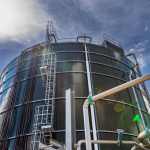The European Biogas Association (EBA) has presented an analysis of achieving climate neutrality by exploiting the potential for biogas production from industrial WWTPs. Analysis presents the high potential for mitigating methane emissions from wastewater, while providing a huge potential source of renewable energy, reducing energy consumption in wastewater treatment plants, and providing the necessary sludge management and additional local jobs.
Possibilities for biogas production from waste water
The service life of wastewater treatment plants is usually 20-25 years, which means that by 2050 every treatment plant will be renovated, reconstructed or replaced at least once. This creates opportunities for more sustainable winemaking through the implementation of biogas technologies.
Many industrial sectors, such as food processing companies as well as the paper industry, produce wastewater that is highly loaded with organics (organic load). Therefore, a purification step is required before disposal. At present, widely applied aerobic wastewater treatment has high energy consumption and produces large amounts of sludge. In an anaerobic pretreatment step, a large fraction of the organic load can be converted to biogas. This means that introducing an anaerobic treatment step before aerobic treatment reduces the amount of waste in the water while producing biogas and thus reduces the need for energy-intensive aeration. Renewable energy is produced and, moreover, anaerobic treatment typically produces ⅕ to 1/10 less sludge than aerobic treatment.
In the production of biogas from industrial wastewater, greenhouse gas emissions can be saved in several directions. First, reduced electricity consumption in wastewater treatment plants leads to a reduction in harmful emissions. Second, greenhouse gas emissions are prevented by replacing energy from fossil fuel sources with renewable energy. Finally, methane emissions are saved by placing the wastewater in a closed and controlled environment.
Renewable energy production
As stated above, industrial wastewater is loaded with organic matter, much of which can be converted into biogas. Some sectors that typically produce wastewater with a high organic content and therefore a high potential for biogas are the potato industry, beer production, paper industry, food and beverage, etc.
According to the analysis, it is possible to recover about 14 Mtoe (142 TWh) of biogas per year by adding value to industrial wastewater from spirits, biodiesel, pulp and paper, beer, vegetable oils, ethanol, meat and cheese. According to various studies, the biogas production potential in Europe in 2050 is in the range of 87 – 114 Mtoe (1008 – 1326 TWh). However, most of these studies still do not consider the large potential of industrial wastewater, which means that the potential for biogas production in Europe may even be higher than currently estimated. Considering the number of anaerobic treatment facilities currently in operation (around 1000 plants in Europe), it becomes apparent that market penetration is currently below 10% at EU level, proving that the majority of the potential for biogas production currently remains untapped.
Reducing methane emissions
The production of biogas from wastewater is a technology for reducing methane emissions and fits perfectly within the framework of the implementation of the methane strategy. In the production of biogas from waste water, methane emissions are prevented by draining the waste water into a closed and controlled container – a methane tank.
Reduced electricity consumption for purification
Aerobic wastewater treatment plants usually have high energy consumption, especially when organic loading is high and aeration requirements are high. By applying biogas production in the industrial wastewater treatment process, the organic load of the wastewater is significantly reduced. This reduction in electricity is achieved by switching waste degradation from oxygen-based oxidation in air to an oxygen-free fermentation process.
This reduces the need for the highly energy-intensive oxygenation step, thus greatly reducing the overall energy consumption of the plant. Aerobic industrial wastewater treatment plants consume up to 5-6 kWh of electricity per m³ of wastewater, mainly for aeration. By applying anaerobic treatment technologies, it is possible to reduce the organic load of industrial wastewater between 75% – 85%. As such, it is possible to reduce current electricity consumption by 75%, which corresponds to approximately 3 Mtoe (32 TWh) per year at EU level.
Less amount of excess activated sludge (AEW)
Aerobic biological treatment technologies generate large amounts of excess sludge. Excess sludge requires treatment in the form of dewatering, drying, anaerobic digestion and/or incineration and eventually becomes waste, and therefore requires treatment in accordance with the Waste Framework Directive 2008/98/EC. When an anaerobic treatment step is included, before or instead of aerobic treatment, the amount of sludge is significantly reduced compared to applying only aerobic treatment.
The amount of sludge produced by aerobic biological treatment technologies is estimated at about 17 million tons of dry matter per year for industrial wastewater in Europe. By implementing anaerobic treatment technologies, it is possible to reduce excess sludge production by up to 70-80% in most cases, which means reduced sludge treatment costs as well. In order to calculate the potential for biogas production from industrial wastewater, calculations were performed for major industrial sectors such as HVP, chemical industry and others.
Contacts:
Do not hesitate to contact our specialist on email sales@atamiq.com or phone +359886163199



